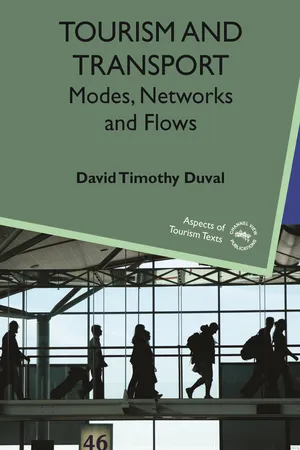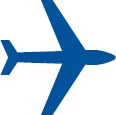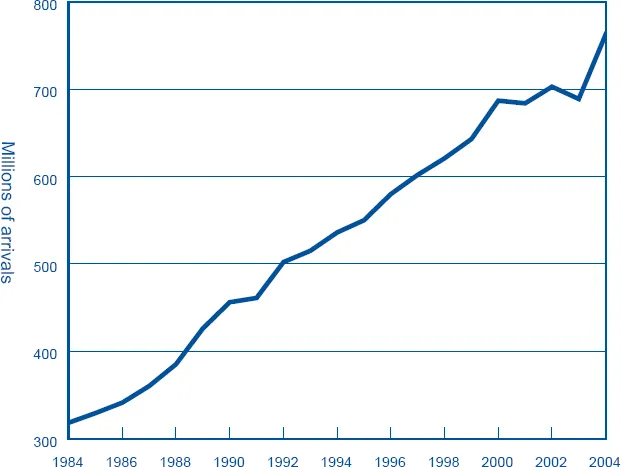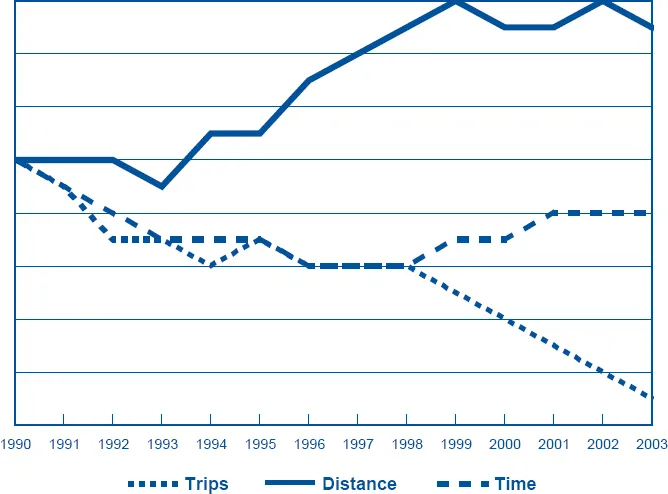![]()
CHAPTER 1:
INTRODUCTION: MANIFESTATIONS OF TRANSPORT AND TOURISM
LEARNING OBJECTIVES
After reading this chapter, you should be able to
1. Understand the complex nature by which transport is tied to tourism and tourism development.
2. Assess and describe the scope of transport operations worldwide, particularly as they relate to travel flows and tourism development.
3. Distinguish and draw correlations between modes, networks and flows and their role (s) in the development of transport networks.
4. Outline the top issues facing transport provision in the context of tourism.
5. Discuss the role of the mode and type of transport in the context of decision-making systems.
INTRODUCTION: A SITUATION ANALYSIS
Transport has emerged as one of the more ubiquitous and complex global economic sectors. It forms the backbone of national and international commerce by acting as a mechanism for the movement of freight and people. As a result, growth in transport systems share synergies with growth in tourism, and vice versa. The global reach of tourist activities has, in part, been facilitated by the increase in accessibility of tourist ‘places’ on a global scale, and the popularity of holidays in western countries that make use of personal transport surged throughout the 20th century, thus spawning consistent demand for accessibility. Importantly, externalities that affect the viability of tourism at varying spatial levels (e.g. attractions, destinations, regions, global) can have flow-on effects to transport. As well, externalities that affect transport provision can impact on tourism demand and tourism development. Indeed, the events of 11 September 2001 in the United States demonstrated the fragility of the global tourism sector and associated transport industries.
Global tourism has grown significantly in the past few decades (Figure 1.1), and even over the past century. The stagnant growth in global tourism between 2001 and 2003 seems to have begun a renewal beginning in 2004 and carrying through to early 2006 (UNWTO, 2005a, 2006). The scope for international travel, according to the IATA, is positive in some regions (e.g. Asia and Middle East) despite overall setbacks experienced in 2005 due to increased costs for fuel spurned by rising oil prices (IATA, 2005). With UNWTO predicting almost 1.6 billion arrivals by 2020 (UNWTO, 2005a), and with several airlines (e.g. Qantas, Emirates) purchasing next-generation aircraft such as the Boeing 787, the Airbus A350 or the A380, the importance of transport provision becomes clear. Developments in transport can, and will, have an enormous impact on people's mobility, and tourist motivation and demand in general already has significant impacts on the way people travel (Hall, 2005). As Hall (2005: 37) notes, tourists have benefited from the introduction of new technologies in transportation, which have been developed as a direct consequence of the rise in demand of travel:
The cost and time of moving commodities, services and people have dramatically reduced in recent years. The real cost of travelling internationally has fallen sharply, as has the time it takes to travel long distances…In the first decade of the twenty-first century marginal increases in the time saved may be achieved but, more significantly, the same flight will be undertaken by double-decker jumbo jets carrying almost twice as many people as the ‘traditional’ jumbo jet.
The Department for Transport in Great Britain established a baseline index from 1990 and plotted the movement of distance, time and number of trips using the National Travel Survey. The result is that the number of trips has decreased steadily since 1990 while distance has increased (Figure 1.2). The amount of time spent travelling (including all forms of travel, not just tourism) has slightly decreased.
A 20-year outlook for commercial air travel produced by Boeing (2005) suggests passenger traffic between 2005 and 2024 will increase by an average of 4.8% per year, and cargo traffic is predicted to increase by an average of 6.2% across the same period. Boeing also predicts the global fleet of aircraft will double by 2024 to over 35,000 commercial aircraft (including both cargo and passenger). Airbus, a competitor, produced its own market outlook report (Airbus, 2005) with similar predictions of growth. Airbus predicts that the number of passenger aircraft in operation will double from almost 11,000 to 22,000 between 2003 and 2023. Airbus is also predicting a doubling of frequencies on existing routes, but only an increase of 20% of the number seats on aircraft.
Figure 1.1 World tourist arrivals (millions)
Source: ITA (US) (2005), based on U.S. Department of Commerce, ITA, and UNWTO
ABOUT THIS BOOK: POSITIONING MODES, NETWORKS AND FLOWS
The broad purpose of this book is to map the key elements that comprise the complex relationship between transport and tourism. A framework of modes, networks and flows, as primary elements that help explain the transport/tourism relationship, is utilised. This framework has largely been adopted from the geography of transport studies literature (e.g. Hoyle & Smith, 1998), although other disciplines such as management, marketing and economics have also utlised similar approaches. Modes, network and flows can be defined as follows:
Modes: Following conventional definitions used in the business management literature with respect to categorising transport operations (see, for example, Gubbins, 2004), transport modes are manifested in three ways: ground transport, air transport and marine transport (a future mode, space transport, is considered in Chapter 9). A particular transport ‘type’ shall refer to the actual means of mobility realised within a particular mode. Thus, cruise tourism can be considered a type of transport that would fall under the marine mode of transport, and low-cost airlines, charter carriers and ‘legacy carriers’, to name a few, can be classified as a type of air transport (differentiated from other carriers on the basis of the business model and network served). While somewhat autocratic and rigid in its function, this classification system allows for consideration of the importance of tourism to each and to showcase useful examples of integration and importance.
Figure 1.2 Relative change of time, distance and number of trips (all types) in Great Britain using a baseline starting point of 1990
Source: Department for Transport (2005) based on the National Travel Survey
Networks: If modes broadly represent the means of travel, then network structure underpins the ability of a mode or type of transport to profitably provide service and facilitate mobility. Hoyle and Smith (1998: 14) summarise the importance of networks succinctly:
A pattern of links and nodes produces a network, a physical arrangement of trans-port facilities; and the design, development and management of that network requires a multifaceted transport system, which is ultimately both a response to demand and an expression of technological capability and economic resources.
Flows: Understandably, the profitability of networks depends on parameters of demand, externalities and competition. Networks are integral, therefore, in positioning modes and flows in the context of tourism such that they help explain how each work together to shape international (and regional/national) tourism. Traffic flows across networks represent the tangible measures of accessibility; they are captured in arrival statistics, load factors and demand models, and are governed by ability of modes and types of transport to service demand for traffic flow. Flows are therefore influenced by factors such as motivation and demand (incorporating economic and social variables) as well as supply.
When viewed as a wider system of variables that influence the transport/tourism relationship, modes, networks and flows can be seen to have a substantial impact on the structure of global tourism. Indeed, it can be argued that there is a significant degree of positive correlation and dependence between each concept:
1. Networks determine flows and flows justify networks: The spatial layout, and subsequent linkages established, of transport networks govern the flow of passengers. Thus, the ability of an airline to offer services to a particular destination, for example, plays an integral role in tourism development as...



